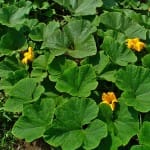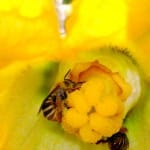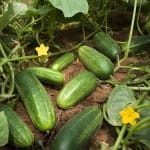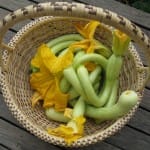Source(s): Richard McQuiston
Cucumbers, squash and pumpkins are all members of the crawling cucurbit family. Give these vine species lots of water, food and wide open spaces.
Planting
All should be sown one or two weeks after the average date of the last frost toward the end of April.
Cucurbits thrive in a rich, sandy loam and are generally grown in hills. Space squash and cucumber hills four to six feet apart. Allow eight feet for pumpkins.
Before you plant, bury about a pound of manure and two handfuls of commercial fertilizer a foot deep in the hill. Place five or six seeds, points down. With squash and cucumbers, bury seeds about an inch deep; with pumpkins, half an inch.
As the plants come up remove all but the best three.
An alternative to cucumbers and squash in hills is rows four to five feet apart. Plant seeds very close to one furrow and train the plants to run toward the other furrow. This practice encourages an adequate supply of water for the root system, while the fruit remains high and dry and safe from rotting.
Growing
You might consider growing your cucumbers out of the garden in barrels, wooden tubs, old boxes or any stable container you have laying around. Just make sure you have a rich soil mixture, preferably equal parts of sandy loam and rotted manure. If you are cramped for garden space, you can train cucumbers to run up wires, trellises, chicken wire or whatever. Just remember to clip the vines as they overlap the top of the device.
Train squash to run on rocks, another method which prevents rotting. Or you can train the vine against a fence which has platforms for large fruit.
Remember cucurbits need lots of water – enough to keep the roots constantly moist during the growing season. Build a small levee around hills or plantings. This acts as a reservoir to hold water until it saturates the ground around roots. There are many variations for irrigation. However you decide to arrange your watering setup, make certain that the fruit does not have prolonged contact with wet ground.
One method growing in popularity is the plastic sheet cover. This plastic film is available at most nurseries. Cover the entire vine area, making holes and slits for the plants and watering. This practice speeds growth, warms the soil, eliminates weeds and keeps the fruit dry. The new landscape fabrics work much the same way.
For best results, apply a liquid fertilizer after the plants are established and before they reach the fruit stage. Cultivate very lightly and maintain a fine mulch of 2″-3″ to eliminate weeds.
Resource(s): Vegetable Gardening in Georgia





